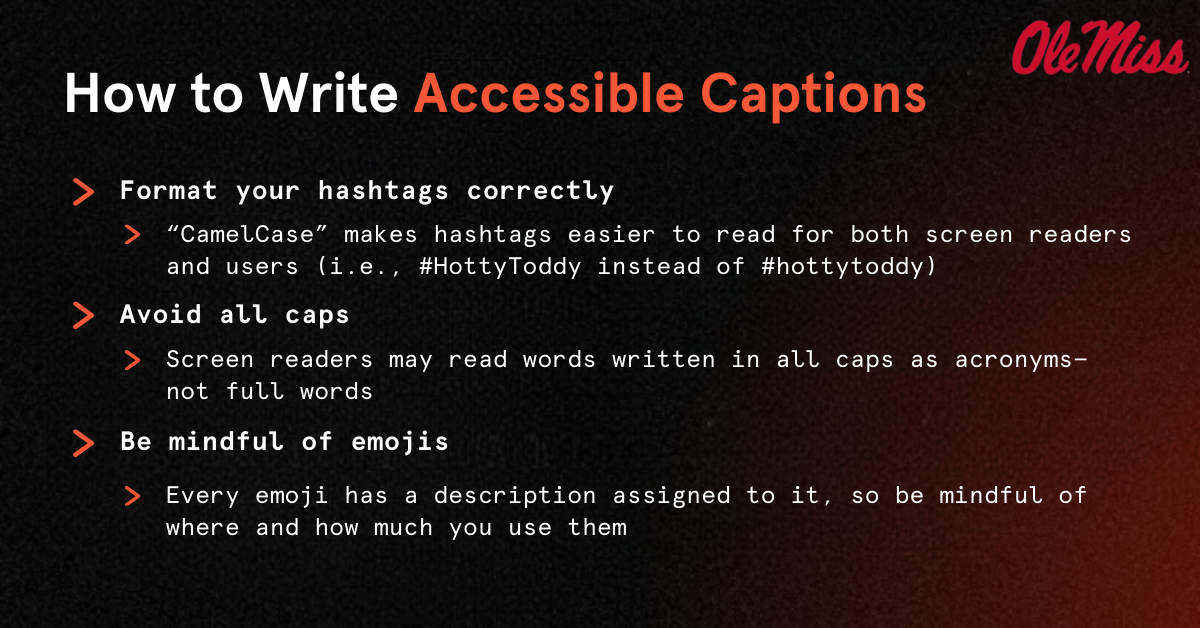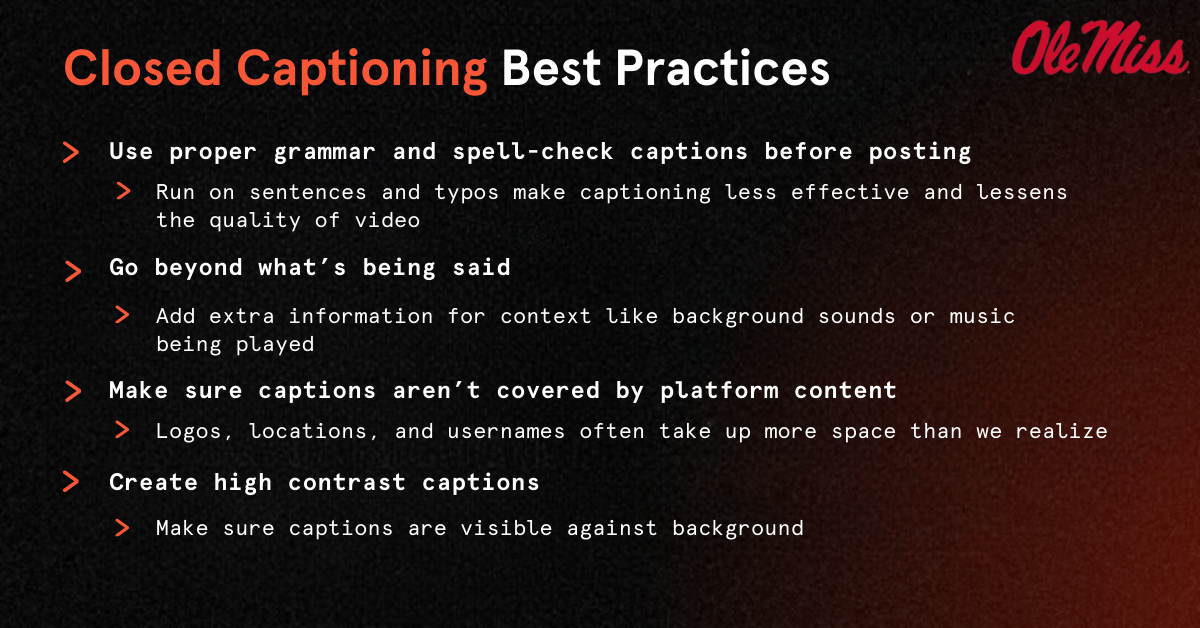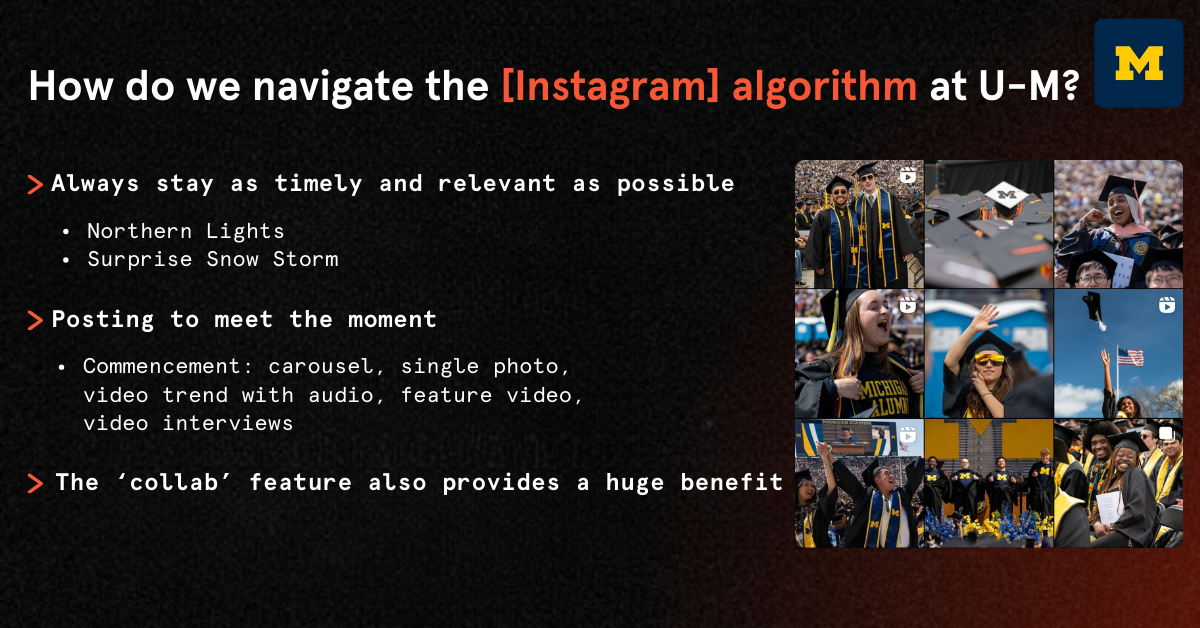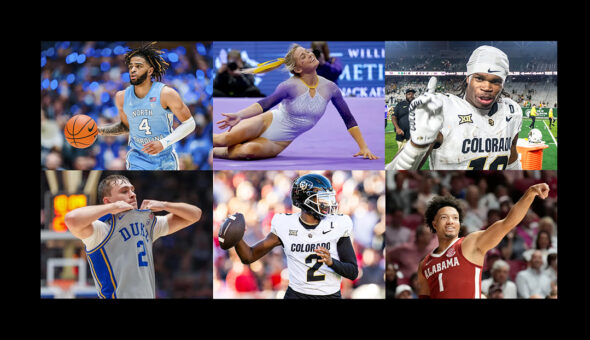I recently attended the Social Media Strategies Summit for Higher Ed, a multi-day online event during which higher ed professionals share their top tips and tricks for social media management. After two days filled with Ask Me Anything sessions and panel discussions, here is a rundown of the common themes that popped up, recommendations I jotted down, and resources that everyone seems to be using.
The Social Media Playbook for Higher Ed: Top Tips from the 2024 Summit
Uncover the latest social media strategies in higher ed, from user-generated content risks to navigating platform algorithms and enhancing content accessibility.

UGC: High Risk, High Reward?
User-generated content (UGC) remains one of the most intuitive ways to connect with students. It’s trendy, engaging and fun — but not necessarily for social media professionals, especially when it comes to on-the-fly account takeovers with same-day stories and unedited live content. Carrie Mills, social media manager at the University of Tennessee, Knoxville, shared that she is trying to scale down the takeovers because of the “time and risk involved.” At UT, students can’t just take over the account; they must be vouched for by a staff member, and their activity is closely monitored. The university is shifting toward pre-recorded UGC, a trend mirrored across the higher ed landscape.
Is this because institutions don’t trust students to uphold their values, or is it simply a necessary safeguard?
Other schools, like UC Berkeley, approach UGC by assembling teams of student influencers or social media interns to pre-record content. Students tend to have a good grasp of current trends and how they apply to their institutions. However, that doesn’t mean their vision always aligns with the social media team’s goals.
Sydney Pridgeon, social media strategist at Berkeley, recalled an intern suggesting they use Duolingo‘s quirky strategy — an approach that didn’t quite fit the university’s image. As Pridgeon put it: “If it’s not appropriate for your mom to see, it probably shouldn’t be on the university account.”
Content Accessibility Is a Must
If your institution is committed to accessibility, your content should be as well. In fact, your institution is most likely legally required to meet the Web Content Accessibility Guidelines (WCAG) 2.1 adopted by the Department of Justice.

Emma Dickerson, digital content specialist at the University of Mississippi, delivered a comprehensive presentation on integrating digital accessibility into daily posts.
The takeaway: Start with alternative text (alt text) to describe images, keep your descriptions under 125 characters, include keywords for SEO and provide context. Also, you should avoid using fun typography, as screen readers may not recognize the text properly, and all caps can be misread as abbreviations.

For video content, closed captions (CC) are essential. Although many social platforms offer automatic captions, Dickerson advised manually adding them to ensure accuracy in spelling and grammar.
If you schedule posts in advance, tools like Sprout Social can help you add alt text ahead of time. In the case of Instagram, you’ll need to manually add alt text after a post goes live.

Algorithms: Do We Know the Rules We’re Playing By?
Social media algorithms are constantly changing — and rarely fully cracked by users. Different platforms cater to different audiences. Facebook skews towards Millennials, parents of prospective/current students and older alumni, while TikTok captures Gen Z and Gen Alpha. Instagram sits in the middle, but trends typically arrive there about two weeks after going viral on TikTok.
Meanwhile, LinkedIn is evolving from a job-seeking platform to more of a career-blogging space, and X (formerly Twitter) is seeing declining engagement but still maintains dedicated higher ed niches.
Erica Colaianne, director of social media at the University of Michigan, hosted a session on navigating the platform algorithms. Colaianne reviewed the social media channels U-M uses, highlighting the unique features and strategies for each. For instance, Instagram’s algorithm shows users content similar to that which they’ve recently engaged.
Facebook evaluates each post based on its outlined criteria and rates it for higher feed placement. LinkedIn prioritizes connections on top of post quality. X hasn’t posted updates on the algorithm since March 2023, yet there have been noticeable changes.
For X, Colaianne recommended focusing on the recency and relevance of the content and posting two to three times per day for higher engagement on trending topics. TikTok tracks your behavior in the app and shows content based on that. Colaianne’s strategy is to “have trends ready to go for when opportunities arise.”
Social Media Best Practices
There is no one-size-fits-all all with social media. Trial and error is a given. The content you spend hours perfecting might get fewer views than a quick five-minute post (a far more common experience than you would think). Still, common strategies have emerged among higher ed social media professionals.
1. Quality over Quantity
If you don’t have meaningful content, don’t post for the sake of it. Mills shared that UT’s beta testing found a correlation between high posting frequency on LinkedIn and declining engagement. The university’s sweet spot? Posting once a day at most, or better yet, two to four times a week.
That trend seems to be true among different types of institutions. Chelsea Doyle, digital community manager at Bowdoin College, mentioned that content posted on the same day tends to compete for engagement rather than amplify it.
Insider Tip: If you are looking for inspiration for your content, don’t just look at other higher ed institutions. Look at other industries and think about how you can adapt them to higher ed. Kaytlyn Gill, social media manager at the University of North Carolina at Charlotte, gets inspiration from Poppi, and Brett Glannon, social media manager at The University of Kansas, looks to food and beverage brands like Cava and Dunkin’.
2. Put on the Audience Hat
If the message is crafted with a current student in mind, it would look weird on Facebook, where parents and alumni would read it. So, if you are posting the same content across multiple channels, Mills suggested tweaking it even a bit for better reception among the audience.
3. Relevance Is Key
It is a useful practice to set some time aside and schedule social media posts in advance. Knowing the university event schedule for the whole academic year can help with posting relevant content.
However, make sure to double-check that the details haven’t changed before the post goes live. For example, if a storm takes down a large tree and you’ve just posted a photo where the tree is still standing, the audience will notice — and they’ll likely comment on it, Doyle shared.
4. Mix in the Veggies
Interlace lighthearted, fun content with more serious institutional messages. Sometimes, posting something that everyone will love (e.g., a dog mascot) can drive those stats up on the statement your president issued on a commencement speaker.
Resource Hub
Staying current with social media trends is key to success. Here are a few go-to resources recommended by experts to keep you in the loop.
- TikTok Creative Center – a hub for insights, trends, and creative inspiration straight from TikTok.
- Instagram’s @Creators – Instagram’s own account dedicated to sharing tips, trends and advice for creators.
- Later Social Media Blog – a blog offering strategic social media insights and tips for all major platforms.
- Rachel Karten’s Link in Bio – a newsletter providing expert social media advice and trend analysis from a seasoned industry professional.
- Sprout Blog – a comprehensive source of social media news, guides and best practices.
And, of course, sign up to Volt’s newsletter to get insights, expert opinions, and the latest trends in higher ed marketing, comms and enrollment — delivered straight to your inbox.
Newsletter Sign up!
Stay current in digital strategy, brand amplification, design thinking and more.
Recent in Marketing & Branding
Also in Marketing & Branding

Higher ed marketing trends shaping an already high-stakes 2025.
From pluralism to branding battles, top voices in higher ed break down the marketing shifts you can’t afford to ignore.

The NIL Top 10: Who are the highest-paid college athletes?
Growing collective contracts and sponsorship deals have university athletes — both men and women — raking in record paydays.

Can generative AI video be used in higher ed marketing?
Although not yet ready for prime time, generative AI video shows potential to transform recruitment, campus tours and storytelling—if humans lead the way.




